Corporate Social Responsibility Report: Market, Philanthropy, Strategy
VerifiedAdded on 2023/04/03
|7
|1415
|331
Report
AI Summary
This report delves into the multifaceted realm of Corporate Social Responsibility (CSR), examining the market conditions that compel businesses to adopt socially responsible practices. It explores the influence of consumer expectations, increased competition, and consumer lobby groups on corporate behavior. The report defines and analyzes the role of philanthropy in business, highlighting its significance in networking, building goodwill, and fostering employee morale, as well as its contribution to Corporate Sustainability and Responsibility (CSR) objectives. Furthermore, it investigates the concept of greenwashing, using the Volkswagen emissions scandal as a case study to illustrate misleading environmental claims. Finally, the report discusses strategic CSR, emphasizing how organizations integrate CSR into their core business strategies to minimize environmental impact and meet stakeholder interests. The report uses IKEA as an example to illustrate strategic CSR implementation.
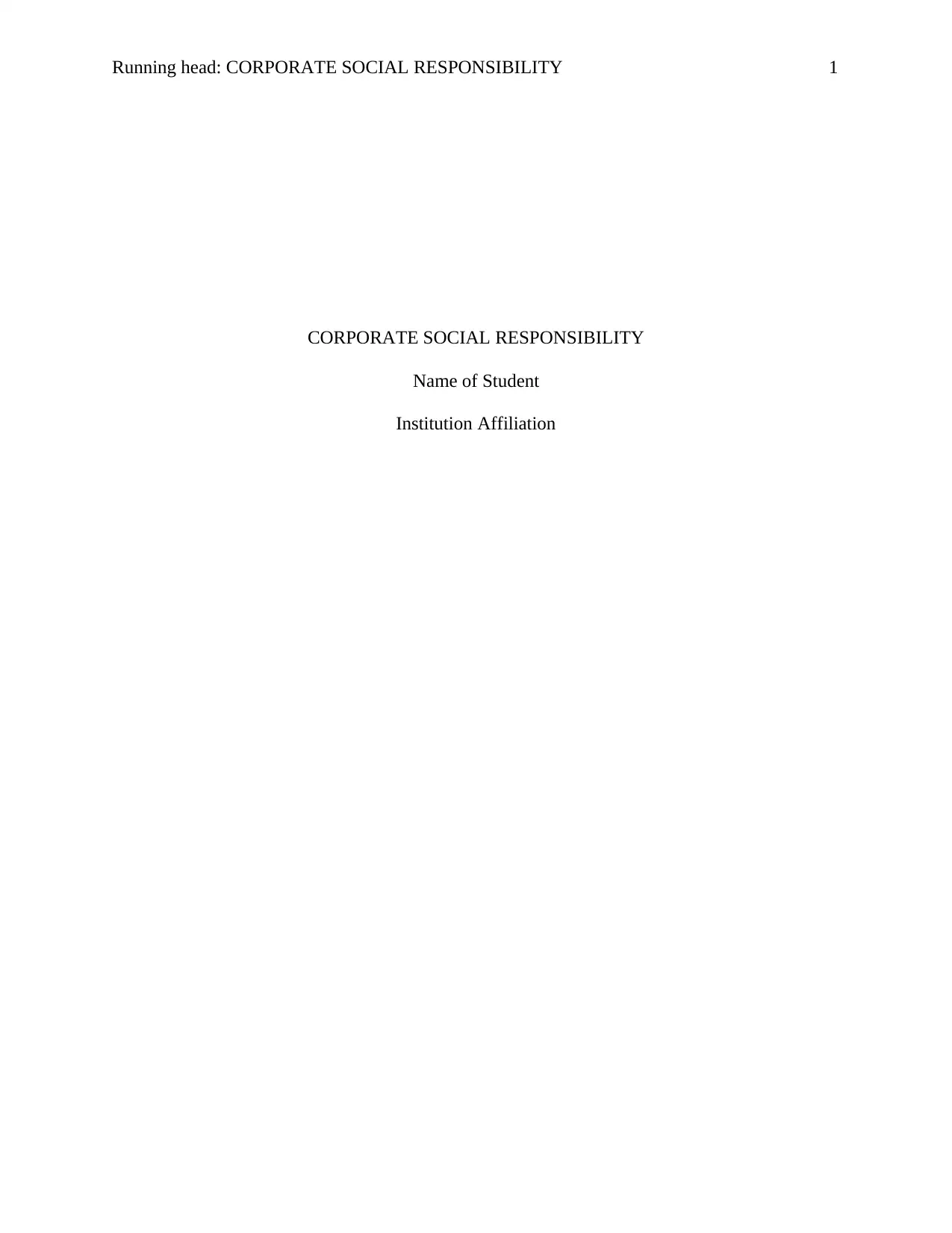
Running head: CORPORATE SOCIAL RESPONSIBILITY 1
CORPORATE SOCIAL RESPONSIBILITY
Name of Student
Institution Affiliation
CORPORATE SOCIAL RESPONSIBILITY
Name of Student
Institution Affiliation
Paraphrase This Document
Need a fresh take? Get an instant paraphrase of this document with our AI Paraphraser
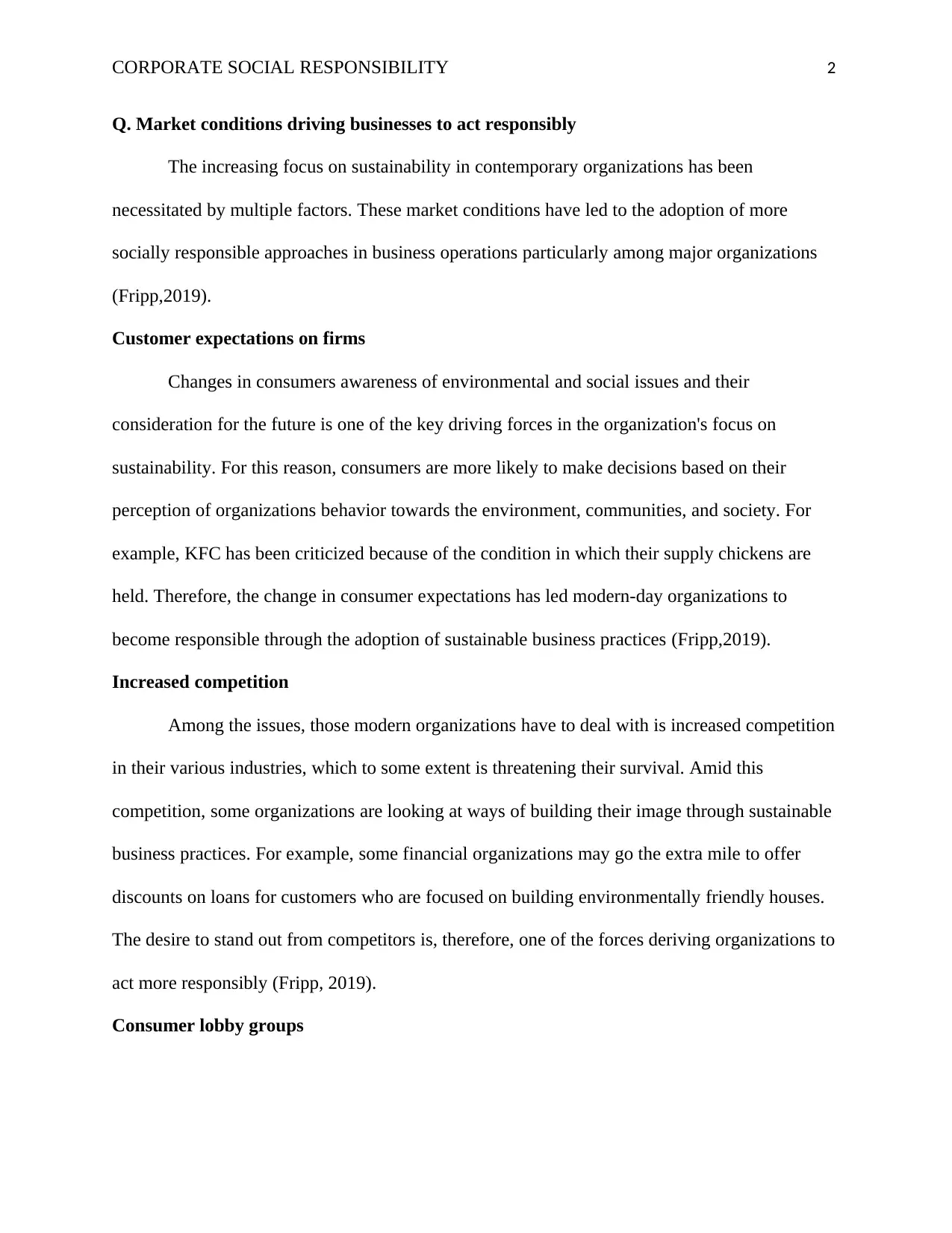
CORPORATE SOCIAL RESPONSIBILITY 2
Q. Market conditions driving businesses to act responsibly
The increasing focus on sustainability in contemporary organizations has been
necessitated by multiple factors. These market conditions have led to the adoption of more
socially responsible approaches in business operations particularly among major organizations
(Fripp,2019).
Customer expectations on firms
Changes in consumers awareness of environmental and social issues and their
consideration for the future is one of the key driving forces in the organization's focus on
sustainability. For this reason, consumers are more likely to make decisions based on their
perception of organizations behavior towards the environment, communities, and society. For
example, KFC has been criticized because of the condition in which their supply chickens are
held. Therefore, the change in consumer expectations has led modern-day organizations to
become responsible through the adoption of sustainable business practices (Fripp,2019).
Increased competition
Among the issues, those modern organizations have to deal with is increased competition
in their various industries, which to some extent is threatening their survival. Amid this
competition, some organizations are looking at ways of building their image through sustainable
business practices. For example, some financial organizations may go the extra mile to offer
discounts on loans for customers who are focused on building environmentally friendly houses.
The desire to stand out from competitors is, therefore, one of the forces deriving organizations to
act more responsibly (Fripp, 2019).
Consumer lobby groups
Q. Market conditions driving businesses to act responsibly
The increasing focus on sustainability in contemporary organizations has been
necessitated by multiple factors. These market conditions have led to the adoption of more
socially responsible approaches in business operations particularly among major organizations
(Fripp,2019).
Customer expectations on firms
Changes in consumers awareness of environmental and social issues and their
consideration for the future is one of the key driving forces in the organization's focus on
sustainability. For this reason, consumers are more likely to make decisions based on their
perception of organizations behavior towards the environment, communities, and society. For
example, KFC has been criticized because of the condition in which their supply chickens are
held. Therefore, the change in consumer expectations has led modern-day organizations to
become responsible through the adoption of sustainable business practices (Fripp,2019).
Increased competition
Among the issues, those modern organizations have to deal with is increased competition
in their various industries, which to some extent is threatening their survival. Amid this
competition, some organizations are looking at ways of building their image through sustainable
business practices. For example, some financial organizations may go the extra mile to offer
discounts on loans for customers who are focused on building environmentally friendly houses.
The desire to stand out from competitors is, therefore, one of the forces deriving organizations to
act more responsibly (Fripp, 2019).
Consumer lobby groups
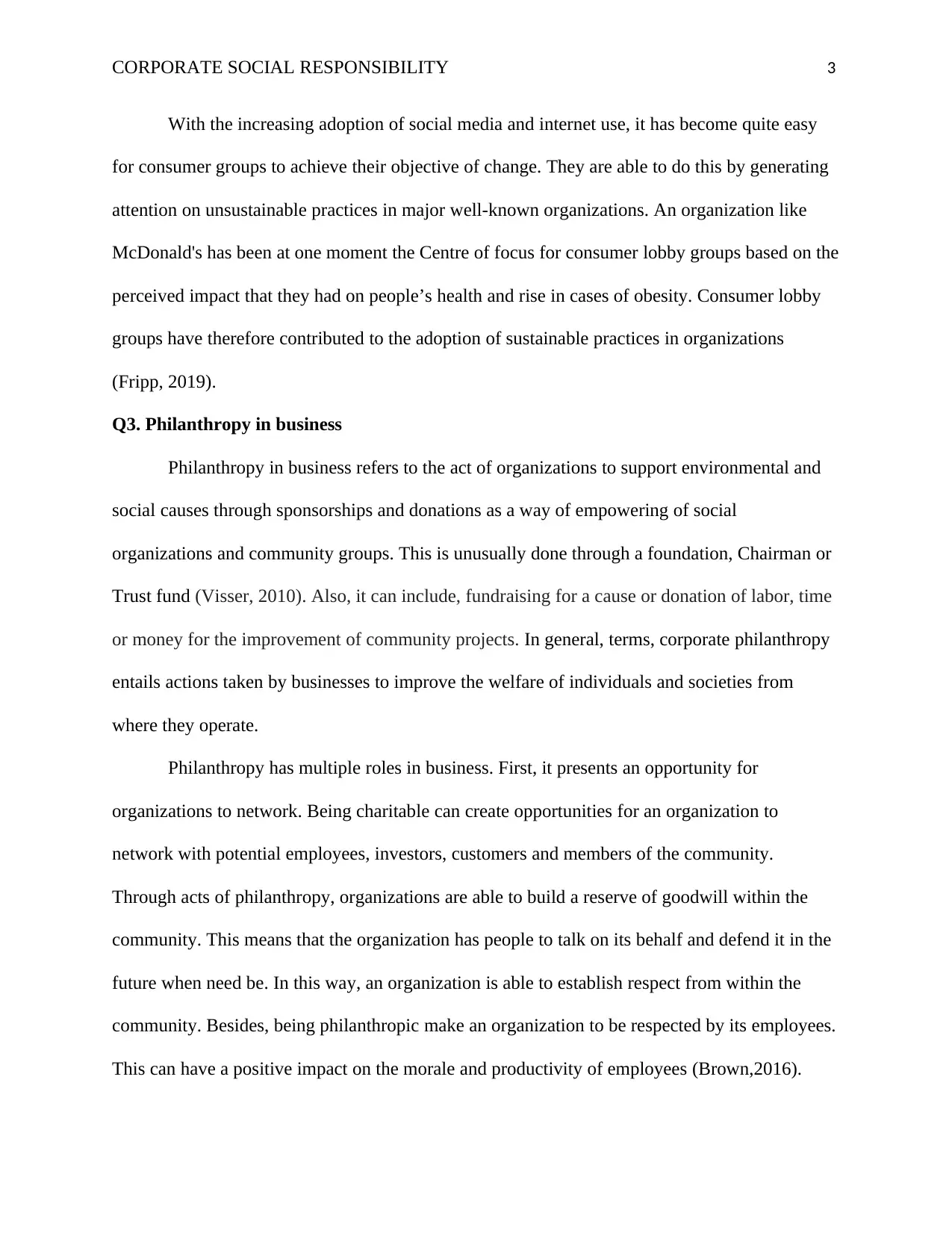
CORPORATE SOCIAL RESPONSIBILITY 3
With the increasing adoption of social media and internet use, it has become quite easy
for consumer groups to achieve their objective of change. They are able to do this by generating
attention on unsustainable practices in major well-known organizations. An organization like
McDonald's has been at one moment the Centre of focus for consumer lobby groups based on the
perceived impact that they had on people’s health and rise in cases of obesity. Consumer lobby
groups have therefore contributed to the adoption of sustainable practices in organizations
(Fripp, 2019).
Q3. Philanthropy in business
Philanthropy in business refers to the act of organizations to support environmental and
social causes through sponsorships and donations as a way of empowering of social
organizations and community groups. This is unusually done through a foundation, Chairman or
Trust fund (Visser, 2010). Also, it can include, fundraising for a cause or donation of labor, time
or money for the improvement of community projects. In general, terms, corporate philanthropy
entails actions taken by businesses to improve the welfare of individuals and societies from
where they operate.
Philanthropy has multiple roles in business. First, it presents an opportunity for
organizations to network. Being charitable can create opportunities for an organization to
network with potential employees, investors, customers and members of the community.
Through acts of philanthropy, organizations are able to build a reserve of goodwill within the
community. This means that the organization has people to talk on its behalf and defend it in the
future when need be. In this way, an organization is able to establish respect from within the
community. Besides, being philanthropic make an organization to be respected by its employees.
This can have a positive impact on the morale and productivity of employees (Brown,2016).
With the increasing adoption of social media and internet use, it has become quite easy
for consumer groups to achieve their objective of change. They are able to do this by generating
attention on unsustainable practices in major well-known organizations. An organization like
McDonald's has been at one moment the Centre of focus for consumer lobby groups based on the
perceived impact that they had on people’s health and rise in cases of obesity. Consumer lobby
groups have therefore contributed to the adoption of sustainable practices in organizations
(Fripp, 2019).
Q3. Philanthropy in business
Philanthropy in business refers to the act of organizations to support environmental and
social causes through sponsorships and donations as a way of empowering of social
organizations and community groups. This is unusually done through a foundation, Chairman or
Trust fund (Visser, 2010). Also, it can include, fundraising for a cause or donation of labor, time
or money for the improvement of community projects. In general, terms, corporate philanthropy
entails actions taken by businesses to improve the welfare of individuals and societies from
where they operate.
Philanthropy has multiple roles in business. First, it presents an opportunity for
organizations to network. Being charitable can create opportunities for an organization to
network with potential employees, investors, customers and members of the community.
Through acts of philanthropy, organizations are able to build a reserve of goodwill within the
community. This means that the organization has people to talk on its behalf and defend it in the
future when need be. In this way, an organization is able to establish respect from within the
community. Besides, being philanthropic make an organization to be respected by its employees.
This can have a positive impact on the morale and productivity of employees (Brown,2016).
⊘ This is a preview!⊘
Do you want full access?
Subscribe today to unlock all pages.

Trusted by 1+ million students worldwide
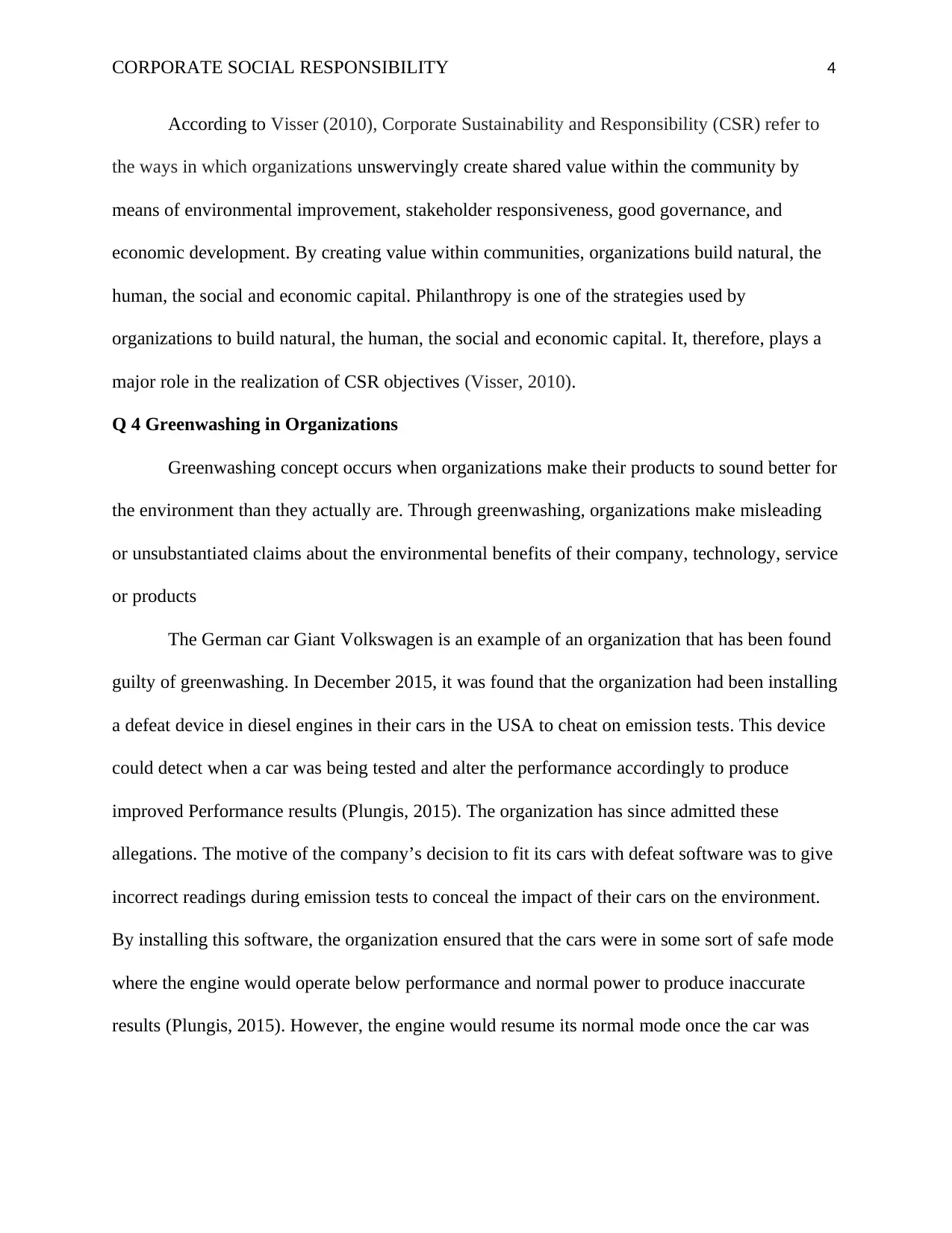
CORPORATE SOCIAL RESPONSIBILITY 4
According to Visser (2010), Corporate Sustainability and Responsibility (CSR) refer to
the ways in which organizations unswervingly create shared value within the community by
means of environmental improvement, stakeholder responsiveness, good governance, and
economic development. By creating value within communities, organizations build natural, the
human, the social and economic capital. Philanthropy is one of the strategies used by
organizations to build natural, the human, the social and economic capital. It, therefore, plays a
major role in the realization of CSR objectives (Visser, 2010).
Q 4 Greenwashing in Organizations
Greenwashing concept occurs when organizations make their products to sound better for
the environment than they actually are. Through greenwashing, organizations make misleading
or unsubstantiated claims about the environmental benefits of their company, technology, service
or products
The German car Giant Volkswagen is an example of an organization that has been found
guilty of greenwashing. In December 2015, it was found that the organization had been installing
a defeat device in diesel engines in their cars in the USA to cheat on emission tests. This device
could detect when a car was being tested and alter the performance accordingly to produce
improved Performance results (Plungis, 2015). The organization has since admitted these
allegations. The motive of the company’s decision to fit its cars with defeat software was to give
incorrect readings during emission tests to conceal the impact of their cars on the environment.
By installing this software, the organization ensured that the cars were in some sort of safe mode
where the engine would operate below performance and normal power to produce inaccurate
results (Plungis, 2015). However, the engine would resume its normal mode once the car was
According to Visser (2010), Corporate Sustainability and Responsibility (CSR) refer to
the ways in which organizations unswervingly create shared value within the community by
means of environmental improvement, stakeholder responsiveness, good governance, and
economic development. By creating value within communities, organizations build natural, the
human, the social and economic capital. Philanthropy is one of the strategies used by
organizations to build natural, the human, the social and economic capital. It, therefore, plays a
major role in the realization of CSR objectives (Visser, 2010).
Q 4 Greenwashing in Organizations
Greenwashing concept occurs when organizations make their products to sound better for
the environment than they actually are. Through greenwashing, organizations make misleading
or unsubstantiated claims about the environmental benefits of their company, technology, service
or products
The German car Giant Volkswagen is an example of an organization that has been found
guilty of greenwashing. In December 2015, it was found that the organization had been installing
a defeat device in diesel engines in their cars in the USA to cheat on emission tests. This device
could detect when a car was being tested and alter the performance accordingly to produce
improved Performance results (Plungis, 2015). The organization has since admitted these
allegations. The motive of the company’s decision to fit its cars with defeat software was to give
incorrect readings during emission tests to conceal the impact of their cars on the environment.
By installing this software, the organization ensured that the cars were in some sort of safe mode
where the engine would operate below performance and normal power to produce inaccurate
results (Plungis, 2015). However, the engine would resume its normal mode once the car was
Paraphrase This Document
Need a fresh take? Get an instant paraphrase of this document with our AI Paraphraser
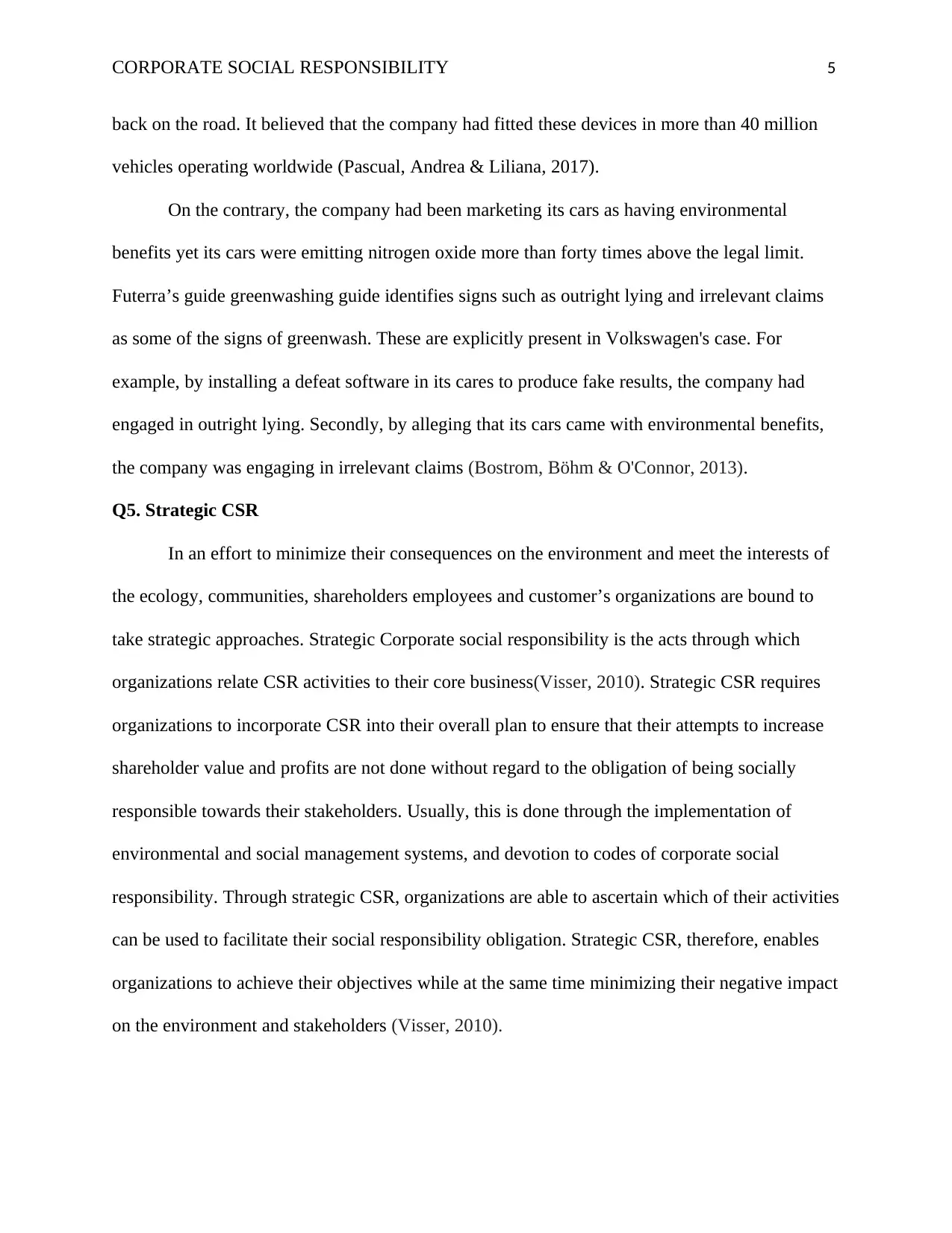
CORPORATE SOCIAL RESPONSIBILITY 5
back on the road. It believed that the company had fitted these devices in more than 40 million
vehicles operating worldwide (Pascual, Andrea & Liliana, 2017).
On the contrary, the company had been marketing its cars as having environmental
benefits yet its cars were emitting nitrogen oxide more than forty times above the legal limit.
Futerra’s guide greenwashing guide identifies signs such as outright lying and irrelevant claims
as some of the signs of greenwash. These are explicitly present in Volkswagen's case. For
example, by installing a defeat software in its cares to produce fake results, the company had
engaged in outright lying. Secondly, by alleging that its cars came with environmental benefits,
the company was engaging in irrelevant claims (Bostrom, Böhm & O'Connor, 2013).
Q5. Strategic CSR
In an effort to minimize their consequences on the environment and meet the interests of
the ecology, communities, shareholders employees and customer’s organizations are bound to
take strategic approaches. Strategic Corporate social responsibility is the acts through which
organizations relate CSR activities to their core business(Visser, 2010). Strategic CSR requires
organizations to incorporate CSR into their overall plan to ensure that their attempts to increase
shareholder value and profits are not done without regard to the obligation of being socially
responsible towards their stakeholders. Usually, this is done through the implementation of
environmental and social management systems, and devotion to codes of corporate social
responsibility. Through strategic CSR, organizations are able to ascertain which of their activities
can be used to facilitate their social responsibility obligation. Strategic CSR, therefore, enables
organizations to achieve their objectives while at the same time minimizing their negative impact
on the environment and stakeholders (Visser, 2010).
back on the road. It believed that the company had fitted these devices in more than 40 million
vehicles operating worldwide (Pascual, Andrea & Liliana, 2017).
On the contrary, the company had been marketing its cars as having environmental
benefits yet its cars were emitting nitrogen oxide more than forty times above the legal limit.
Futerra’s guide greenwashing guide identifies signs such as outright lying and irrelevant claims
as some of the signs of greenwash. These are explicitly present in Volkswagen's case. For
example, by installing a defeat software in its cares to produce fake results, the company had
engaged in outright lying. Secondly, by alleging that its cars came with environmental benefits,
the company was engaging in irrelevant claims (Bostrom, Böhm & O'Connor, 2013).
Q5. Strategic CSR
In an effort to minimize their consequences on the environment and meet the interests of
the ecology, communities, shareholders employees and customer’s organizations are bound to
take strategic approaches. Strategic Corporate social responsibility is the acts through which
organizations relate CSR activities to their core business(Visser, 2010). Strategic CSR requires
organizations to incorporate CSR into their overall plan to ensure that their attempts to increase
shareholder value and profits are not done without regard to the obligation of being socially
responsible towards their stakeholders. Usually, this is done through the implementation of
environmental and social management systems, and devotion to codes of corporate social
responsibility. Through strategic CSR, organizations are able to ascertain which of their activities
can be used to facilitate their social responsibility obligation. Strategic CSR, therefore, enables
organizations to achieve their objectives while at the same time minimizing their negative impact
on the environment and stakeholders (Visser, 2010).
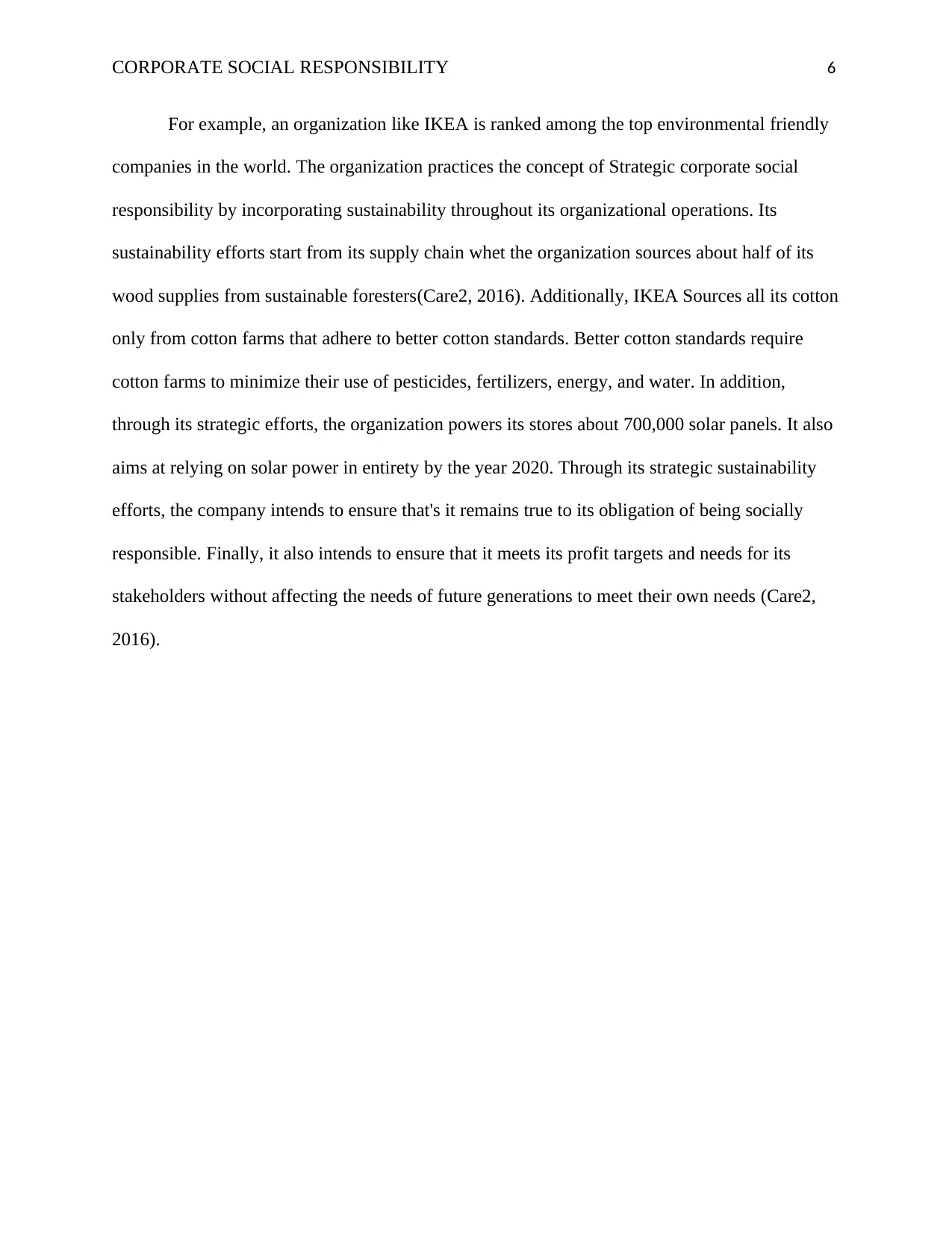
CORPORATE SOCIAL RESPONSIBILITY 6
For example, an organization like IKEA is ranked among the top environmental friendly
companies in the world. The organization practices the concept of Strategic corporate social
responsibility by incorporating sustainability throughout its organizational operations. Its
sustainability efforts start from its supply chain whet the organization sources about half of its
wood supplies from sustainable foresters(Care2, 2016). Additionally, IKEA Sources all its cotton
only from cotton farms that adhere to better cotton standards. Better cotton standards require
cotton farms to minimize their use of pesticides, fertilizers, energy, and water. In addition,
through its strategic efforts, the organization powers its stores about 700,000 solar panels. It also
aims at relying on solar power in entirety by the year 2020. Through its strategic sustainability
efforts, the company intends to ensure that's it remains true to its obligation of being socially
responsible. Finally, it also intends to ensure that it meets its profit targets and needs for its
stakeholders without affecting the needs of future generations to meet their own needs (Care2,
2016).
For example, an organization like IKEA is ranked among the top environmental friendly
companies in the world. The organization practices the concept of Strategic corporate social
responsibility by incorporating sustainability throughout its organizational operations. Its
sustainability efforts start from its supply chain whet the organization sources about half of its
wood supplies from sustainable foresters(Care2, 2016). Additionally, IKEA Sources all its cotton
only from cotton farms that adhere to better cotton standards. Better cotton standards require
cotton farms to minimize their use of pesticides, fertilizers, energy, and water. In addition,
through its strategic efforts, the organization powers its stores about 700,000 solar panels. It also
aims at relying on solar power in entirety by the year 2020. Through its strategic sustainability
efforts, the company intends to ensure that's it remains true to its obligation of being socially
responsible. Finally, it also intends to ensure that it meets its profit targets and needs for its
stakeholders without affecting the needs of future generations to meet their own needs (Care2,
2016).
⊘ This is a preview!⊘
Do you want full access?
Subscribe today to unlock all pages.

Trusted by 1+ million students worldwide
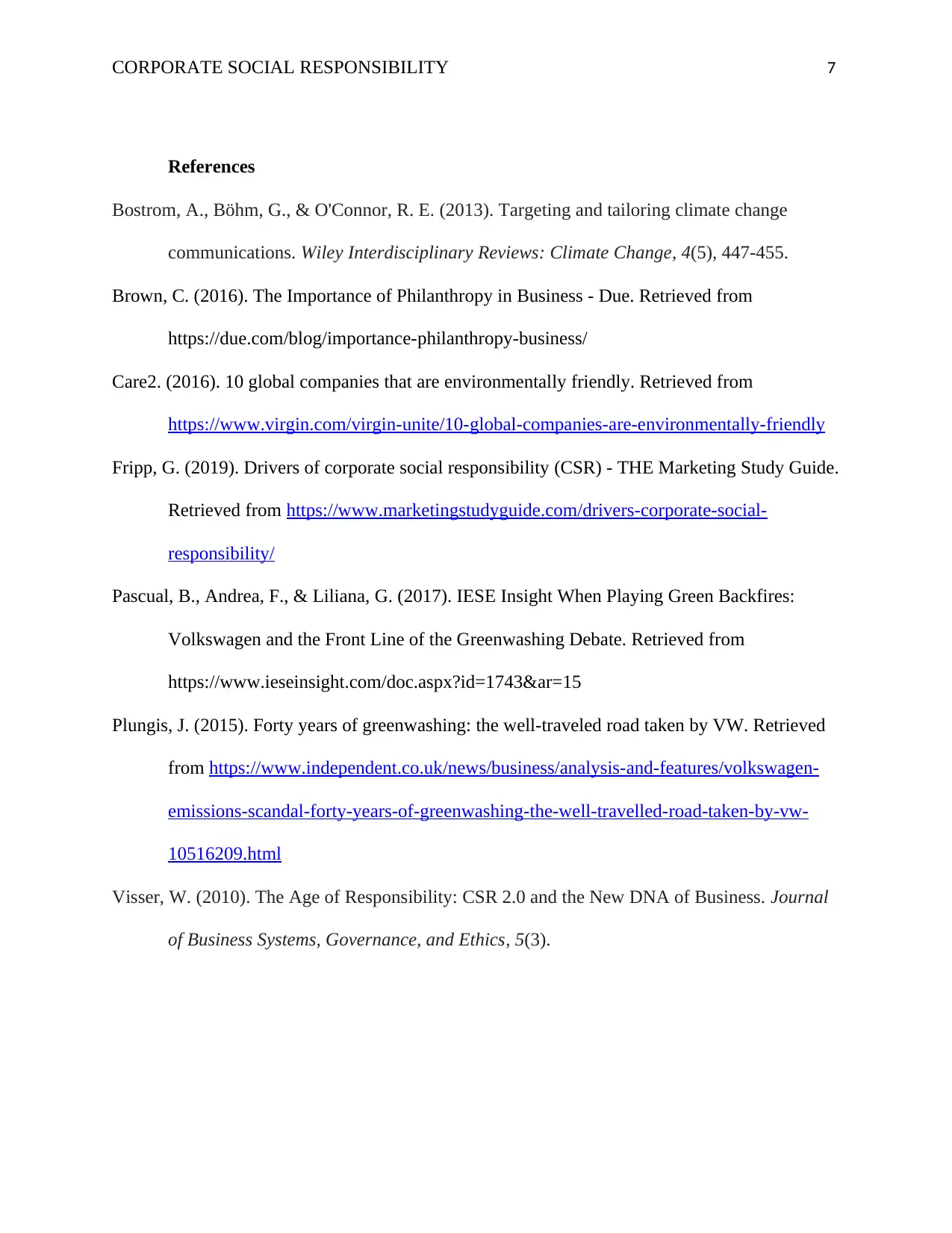
CORPORATE SOCIAL RESPONSIBILITY 7
References
Bostrom, A., Böhm, G., & O'Connor, R. E. (2013). Targeting and tailoring climate change
communications. Wiley Interdisciplinary Reviews: Climate Change, 4(5), 447-455.
Brown, C. (2016). The Importance of Philanthropy in Business - Due. Retrieved from
https://due.com/blog/importance-philanthropy-business/
Care2. (2016). 10 global companies that are environmentally friendly. Retrieved from
https://www.virgin.com/virgin-unite/10-global-companies-are-environmentally-friendly
Fripp, G. (2019). Drivers of corporate social responsibility (CSR) - THE Marketing Study Guide.
Retrieved from https://www.marketingstudyguide.com/drivers-corporate-social-
responsibility/
Pascual, B., Andrea, F., & Liliana, G. (2017). IESE Insight When Playing Green Backfires:
Volkswagen and the Front Line of the Greenwashing Debate. Retrieved from
https://www.ieseinsight.com/doc.aspx?id=1743&ar=15
Plungis, J. (2015). Forty years of greenwashing: the well-traveled road taken by VW. Retrieved
from https://www.independent.co.uk/news/business/analysis-and-features/volkswagen-
emissions-scandal-forty-years-of-greenwashing-the-well-travelled-road-taken-by-vw-
10516209.html
Visser, W. (2010). The Age of Responsibility: CSR 2.0 and the New DNA of Business. Journal
of Business Systems, Governance, and Ethics, 5(3).
References
Bostrom, A., Böhm, G., & O'Connor, R. E. (2013). Targeting and tailoring climate change
communications. Wiley Interdisciplinary Reviews: Climate Change, 4(5), 447-455.
Brown, C. (2016). The Importance of Philanthropy in Business - Due. Retrieved from
https://due.com/blog/importance-philanthropy-business/
Care2. (2016). 10 global companies that are environmentally friendly. Retrieved from
https://www.virgin.com/virgin-unite/10-global-companies-are-environmentally-friendly
Fripp, G. (2019). Drivers of corporate social responsibility (CSR) - THE Marketing Study Guide.
Retrieved from https://www.marketingstudyguide.com/drivers-corporate-social-
responsibility/
Pascual, B., Andrea, F., & Liliana, G. (2017). IESE Insight When Playing Green Backfires:
Volkswagen and the Front Line of the Greenwashing Debate. Retrieved from
https://www.ieseinsight.com/doc.aspx?id=1743&ar=15
Plungis, J. (2015). Forty years of greenwashing: the well-traveled road taken by VW. Retrieved
from https://www.independent.co.uk/news/business/analysis-and-features/volkswagen-
emissions-scandal-forty-years-of-greenwashing-the-well-travelled-road-taken-by-vw-
10516209.html
Visser, W. (2010). The Age of Responsibility: CSR 2.0 and the New DNA of Business. Journal
of Business Systems, Governance, and Ethics, 5(3).
1 out of 7
Related Documents
Your All-in-One AI-Powered Toolkit for Academic Success.
+13062052269
info@desklib.com
Available 24*7 on WhatsApp / Email
![[object Object]](/_next/static/media/star-bottom.7253800d.svg)
Unlock your academic potential
Copyright © 2020–2025 A2Z Services. All Rights Reserved. Developed and managed by ZUCOL.




